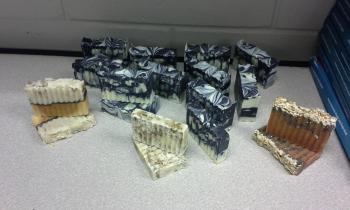
Teaching Science while Making Artisian Soaps

- School:
- Palmetto Ridge High
- Subject:
- Stem
- Teacher:
- Allison Chapman
- Students Impacted:
- 750
- Grade:
- 11
- Date:
- July 1, 2015
Investor
Thank you to the following investor for funding this grant.
Mary Seaton Breese - $439.00
Original Grant Overview
Goal
To motivate, introduce, learn and review science and chemistry concepts while making artisan soaps.
Standard(s): Lab Safety; Properties of Matter; Chemical vs Physical Properties and Changes; endothermic vs exothermic processes and reactions; Acid-Base Chemistry; pH & titrations.
What will be done with my students
Students will melt solid fats using low heat and dissolve lye in an ice cube bath while wearing goggles, gloves and lab apron.
Students will take the temperature of the oil and fat mixture and the lye solution using an infrared thermometer and mix the lye solution into the fat/oil mixture.
Students learned about excess and limiting reagents by superfatting the soap and perform a pH lather test and then titrate the soap after it has cured for at least 4 weeks.
Benefits to my students
Students will follow safety procedures and see first and experience first hand that the melting of palm shortening is an endothermic process and that dissolving lye in water makes a homogeneous mixture and is an exothermic process. They will witness phase changes and measure the temperatures using an infrared thermometer.
Students will witness the difference between physical and chemical changes while watching the saponification reaction that changes fat and lye into soap. They will also measure pH and perform an acid base titration while performing quality assurance tests on their batch of soap.
Budget Narrative
We currently have all the equipment and lye needed to make soap again this year. We just need more fats/oils/colorants and fragrance to make soap with this years' students. I would also like to purchase an infrared thermometer for this on-going lab project.
Last year Whole Foods donated 400 soap bags, coconut oil and some essential oils like peppermint, lavender and tea tree oils to help us make even better artisan soaps.
NCH also donated disposable gloves to be used during this lab. I will ask them to donate the gloves again this year. I also plan to request donations of olive oil from stores like WHOLE FOODS, Publix, Target, Sams Club and CostCo. in order to keep the costs for this lab as low as possible.
Items
| # | Item | Cost |
|---|---|---|
| 1 | pomace olive oil | $273.00 |
| 2 | essential oils | $78.00 |
| 3 | infrared thermometer | $45.00 |
| 4 | colorants | $22.00 |
| 5 | fragrance | $21.00 |
| 6 | gloves | $0.00 |
| 7 | lye | $0.00 |
| 8 | palm oil | $0.00 |
| 9 | distilled water | $0.00 |
| 10 | soap bags | $0.00 |
| Total: | $439.00 |



Share
Please share this page to help in fulfilling this grant.
Email to a Friend